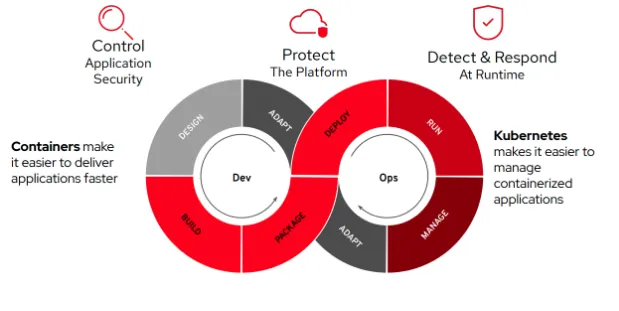In this post:
-
See how the CIA triad, a DevSecOps approach, and a unified automation strategy can help you implement a security-focused hybrid cloud plan.
-
Learn about how products like Red Hat Enterprise Linux and Red Hat Advanced Cluster Security for Kubernetes can help you minimize operational risk.
It goes without saying that no matter where you are in your hybrid cloud journey, security is a primary concern. In this post, we'll look at improving your hybrid cloud security to try to avoid data breaches.
What are some security challenges in hybrid cloud environments?
Some security challenges in hybrid cloud environments include:
-
Securing your data: Since the same data will either be in transit or at rest at different moments in time (and across different locations), data exposure is a real possibility in hybrid cloud environments.
-
Disconnected teams: When development, operations and security teams take a siloed approach to security in hybrid cloud environments, it can result in security gaps, duplicated efforts and more.
-
Streamlining compliance and governance: Manually implementing regulatory security baselines, preparing for security audits and checking your distributed environments for compliance can cost you time and money.
Lagging behind in any of these three areas can open the door to unauthorized users hoping to gain access to sensitive data and internal resources.
So what can be done?
3 tips for deploying a security-focused hybrid cloud strategy
1. Make sure your data addresses the CIA triad
In hybrid cloud environments, your data is not only at rest, in motion, or in action in your on-premise datacenter, but also across one or more public clouds. This makes securing your data all the more critical—and complicated.
We can work towards data security by following what’s known as the CIA triad, or three key aspects of data security:
-
Confidentiality: Restricting data access to those who are authorized to use it.
-
Integrity: Ensuring that data has not been altered or deleted by an unauthorized party.
-
Availability: Ensuring that data will be available when it’s needed.
But what does addressing the CIA triad look like in hybrid cloud environments?
It will look different depending on where your data is in its life cycle, but take data at rest for example. Ensuring confidentiality in data at rest could look like encrypting your data, and integrity could look like verifying that encrypted data. Availability could mean making sure that data is backed up.
Red Hat can help you address the CIA triad. Our products built from Red Hat Enterprise Linux (RHEL) inherit core security features such as standardized crypto policies and Security-Enhanced Linux (SELinux).
For example, Red Hat Openshift Data Foundation, our hybrid cloud storage platform for Red Hat OpenShift, leverages the certified, independently validated cryptography provided by RHEL to allow you to encrypt data at rest or in motion for your hybrid cloud.
2. Unify security across your organization using a DevSecOps approach
In DevSecOps, security, development and operations teams share the responsibility of integrating security throughout the entire IT life cycle. Implementing DevSecOps means thinking about application and infrastructure security from the start.
DevSecOps is very much your friend when it comes to deploying a security-focused hybrid cloud—but what does it actually look like in hybrid cloud environments?
First, understand that culture should be at the front of mind when it comes to DevSecOps. Some aspects of a healthy DevSecOps culture in hybrid cloud environments include:
-
Training: Training developers on secure coding practices.
-
Transparency: Eliminating silos and providing visibility into Ops tools.
-
Shared goals: Defining and measuring KPIs throughout the pipeline.
-
Security automation: Automating security at every point in the life cycle.
While culture is important, you’ll also want to make sure that your hybrid cloud technology simplifies DevSecOps as much as possible.
This means that, since containers and Kubernetes are what enable many hybrid clouds today, you need a security platform that both protects your entire Kubernetes environment and makes DevSecOps easier.

Red Hat Advanced Cluster Security for Kubernetes, our enterprise-ready, Kubernetes-native container security solution, integrates with DevOps and security tools to help you mitigate threats and enforce security policies that minimize operational risk to your applications.
Another Red Hat product that can help simplify a DevSecOps approach is Red Hat OpenShift Platform Plus, which brings together tools you need to manage multiple clusters in a hybrid cloud environment.
3. Implement a unified automation strategy to streamline compliance and governance
Automation helps you reduce risk associated with human errors, helps to bake security in from the start, and allows for everything-as-code. With automation, you can streamline your compliance and governance with:
-
Traceability and repeatability for compliance.
-
Consistent configuration and management across a multivendor environment.
-
Automated rollout of policy, system updates and firewalls across the entire network
In an ideal world, you would have a common automation language across the hybrid cloud stack, one that is simple for your existing DevSecOps teams and your new hires to learn. Having a common automation language provides a layer of interoperability and collaboration for all IT teams.
With Red Hat Ansible Automation Platform, you can take advantage of a leading automation platform that includes a curated collection of modules, roles and playbooks to help investigate and respond to security threats.
Learn more about how easy provisioning cloud infrastructures with Ansible can be.
Conclusion
Security is a big concern no matter where you are in your hybrid cloud journey, so practicing hybrid-cloud security hygiene is important to responding to vulnerabilities in software.
Whether it be securing data, connecting teams or streamlining compliance and governance, it can be challenging to implement healthy hybrid cloud security measures—but Red Hat’s portfolio can help you address these concerns.
We gave a few examples of how Red Hat Openshift Data Foundation, Red Hat Advanced Cluster Security for Kubernetes, and Red Hat Ansible Automation Platform can help you deploy a security-focused hybrid cloud.
저자 소개
Bill Cozens is a recent UNC-Chapel Hill grad interning as an Associate Blog Editor for the Red Hat Blog.
유사한 검색 결과
From incident responder to security steward: My journey to understanding Red Hat's open approach to vulnerability management
Slash VM provisioning time on Red Hat Openshift Virtualization using Red Hat Ansible Automation Platform
What Is Product Security? | Compiler
Technically Speaking | Security for the AI supply chain
채널별 검색
오토메이션
기술, 팀, 인프라를 위한 IT 자동화 최신 동향
인공지능
고객이 어디서나 AI 워크로드를 실행할 수 있도록 지원하는 플랫폼 업데이트
오픈 하이브리드 클라우드
하이브리드 클라우드로 더욱 유연한 미래를 구축하는 방법을 알아보세요
보안
환경과 기술 전반에 걸쳐 리스크를 감소하는 방법에 대한 최신 정보
엣지 컴퓨팅
엣지에서의 운영을 단순화하는 플랫폼 업데이트
인프라
세계적으로 인정받은 기업용 Linux 플랫폼에 대한 최신 정보
애플리케이션
복잡한 애플리케이션에 대한 솔루션 더 보기
가상화
온프레미스와 클라우드 환경에서 워크로드를 유연하게 운영하기 위한 엔터프라이즈 가상화의 미래
